Development and gentrification pressures -- which have succeeded in ultimately forcing the gym to move -- are a direct consequence and culmination of the city-driven Kings Regeneration planning initiative of the mid-1990s. This initiative continues to transform the area, for better -- and sometimes, as in this case -- for worse.
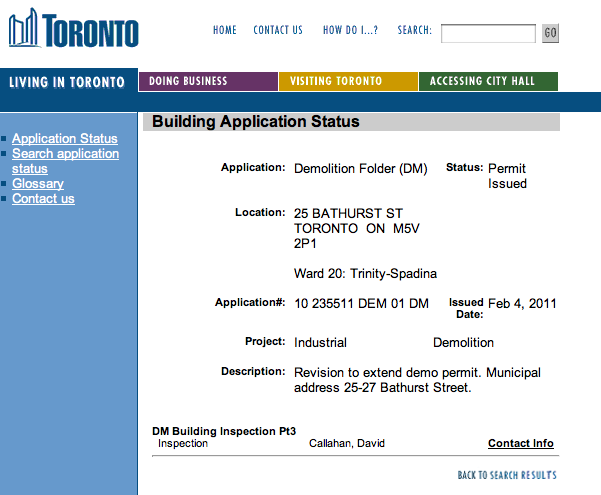 |
| The writing is on the wall for our beloved climbing gym, Rock Oasis |
Historically, the downtown core zone known as 'King-Spadina' -- roughly bounded by Bathurst on the west, Simcoe to the east, and south of Queen St W to Front Street -- was one of Toronto's primary industrial and traditional manufacturing districts.
 |
| Would you believe this is actually Jane Jacob's fault? |
Zoning regulations prohibited other types of development, and vacancy rates increased dramatically. Warehouses lay empty or shuttered; urban decay set in. In order to reduce realty taxes, property owners began to demolish structures without regard to historical legacy or context.
The area became semi-derelict and somewhat abandoned, missing the rumbling pulse and presence of industry. It was in these uneasy conditions that the Rock Oasis climbing gym was founded.
(read Interview with Oasis' Founder: A Climbing Gym Story for a description of the gym's operating history).
Mayor Barbara Hall
shepherded the new
policy to fruition |
Influenced heavily by Jane Jacobs and guided by City Planner Paul Bedford, the initiative was designed to encourage new development and to spur "a diversity of use within the context of consistent built form -- based on the area's heritage". [King Spadina Secondary Plan Review]
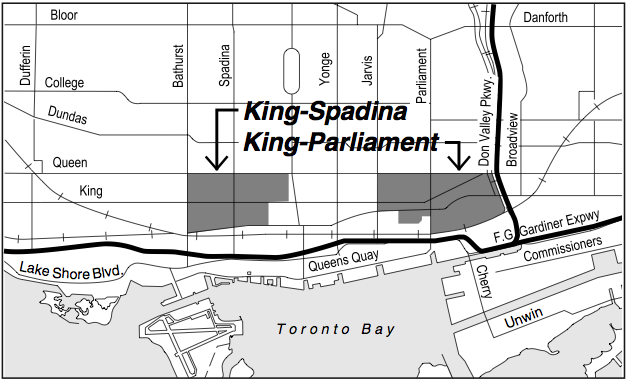 |
| Delineating the King-Spadina and King-Parliament Reinvestment Areas Regeneration in the Kings, Dill/Bedford, City of Toronto Planning Division, Sept 2002 |
In April 1996, Toronto City Council approved the "Part II Official Plan and Zoning By-Law amendments in King-Spadina" (later carried forward as the King Spadina Secondary Plan in Section 16, Chapter 6 of the new City of Toronto Official Plan). To encourage the re-use of existing buildings, a full range of commercial, light industrial, institutional, recreational, and residential uses were permitted.
"Yes, there are risks to this new planning approach, but there is a greater risk if we do nothing."
- Mayor Barbara Hall re: Kings Regeneration Initiative
King-Spadina was established as a 'Reinvestment Area', and developers immediately began to take advantage of the innovative planning framework and its novel zoning flexibility.
Paul Bedford, the City Planner
who put together and championed
the initiative, which would have
far reaching effects
|
Twenty Niagara
The signature project that arguably kicked off the entire wave of condo construction in the Wellington Place neighbourhood was Twenty Niagara. Its success proved to city planners -- and developers looking for new territory to conquer -- that residential development in the area was possible, and desirable.
 |
| Twenty Niagara overlooking Victoria Memorial Park |
Twenty Niagara was built in 1996 by Cohen and Alter, the predecessor to Context Development, a boutique development corporation run by Howard Cohen. A 22 unit modernist glass condo that faced onto Victoria Memorial Park, Twenty Niagara was (at the time) a lonely and isolated residential island, plunked into an industrial wasteland.
Drawing on his experience from 1978 to 1987 as president of the Harbourfront Corporation, and earlier as Chief Planner, Neighbourhoods for the City of Toronto in the 1970s, Cohen saw the untapped potential in the area. He and his (then) development partner, architect Lloyd Alter, determined they had to take the risk.
Interviewed by the New York Times, Cohen said:
“An opportunity came up for a really interesting site, because it was right on a park in this quasi-industrial area, but very close to Toronto’s core. We thought there might be some demand to live downtown in an area that had a lot of character, although it didn’t appeal to everybody because it was still full of old industrial buildings and parking lots.”
 |
| Howard Cohen of Context Developments (National Post, Feb 12, 2010) |
It was a bold move. The building's clean design, by Peter Clewes of architectsAlliance (the project architect was Rudy Wallman -- Wallman Clewes Bergman later merged with another firm to become architectsAlliance), won the project multiple awards, including one for architectural excellence from the Ontario Association of Architects. Because of the challenging location, units in the building originally took about a year to sell, at $100 per square foot. Prices in the fashion district have recently hit $700 per square foot, according to Cohen -- a testament to the growth and buoyancy of the area.
Freed Developments
The transformation of 'the fashion district' had begun. The initial success of Twenty Niagara was precedent-setting. It paved the way for intense competition from other residential developers, who now understood the value in the area. Notable among these developers was Peter Freed, president of Freed Developments.
"No one has been as responsible for the gentrification of the King Street West area as Freed."
Toronto Star, March 4, 2008 (Tony Wong)
 |
| Peter Freed |
A late night hot spot with a spectacular and exclusive rooftop patio, the Thompson Hotel is in some ways Peter Freed's most prominent stamp on the area. It incorporates a telling example of contemporary façadism -- the art deco front of the 1940 International Harvester Building (architect: Norman Armstrong) -- which had been kept for Crangle's Collision -- was torn down, then deftly re-created as part of the new structure.
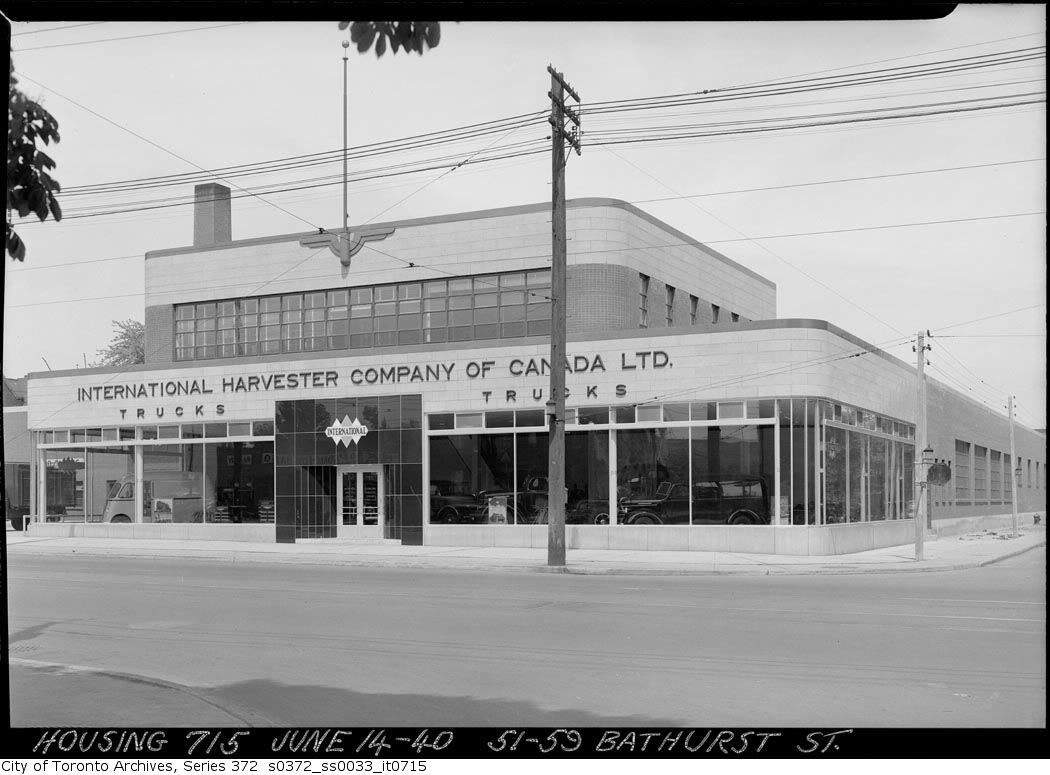 |
| The International Harvester building, 1940 |
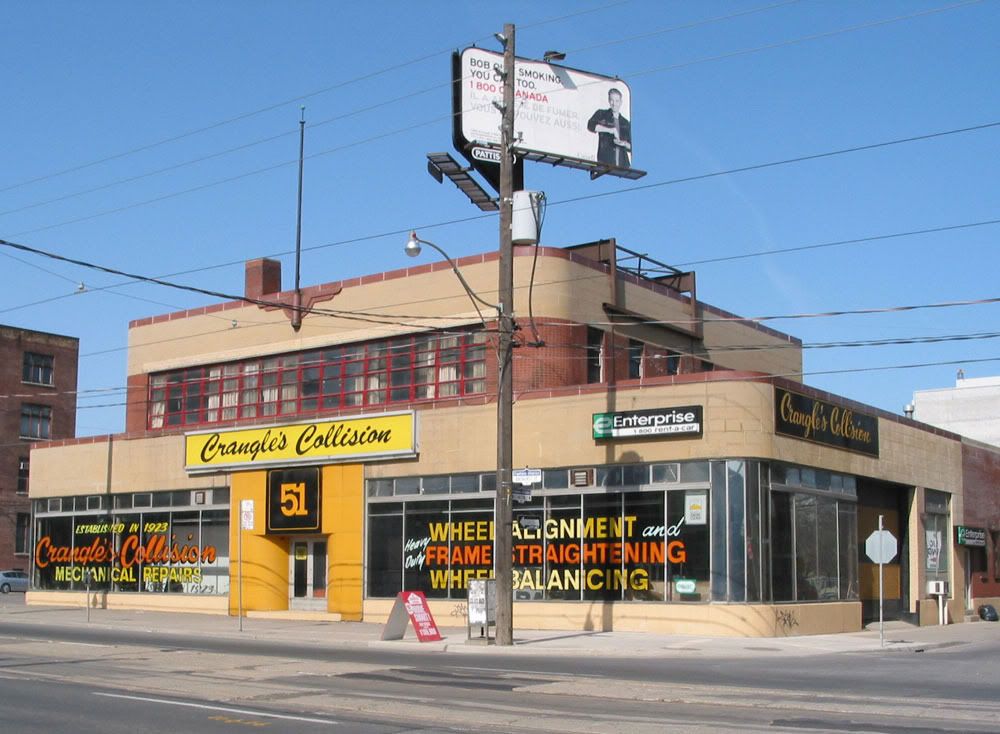 |
| Crangle's Collision, late 2000s |
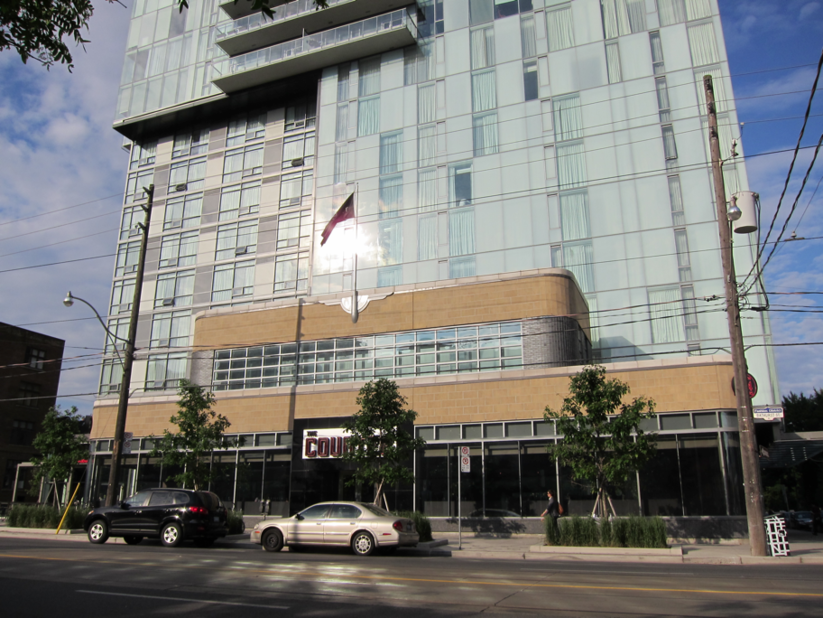 |
| Thompson Hotel, 2011: Is this what 'preserving the built form' means in Toronto? |
The Thompson Hotel site was purchased for $13.2 million in 2006 from its previous owners, Crangle's Collision.
"The property became more valuable than the business." - Les Crangle, Globe and Mail, May 5, 2006
The architect on the Thompson project was -- surprise surprise -- Peter Clewes.
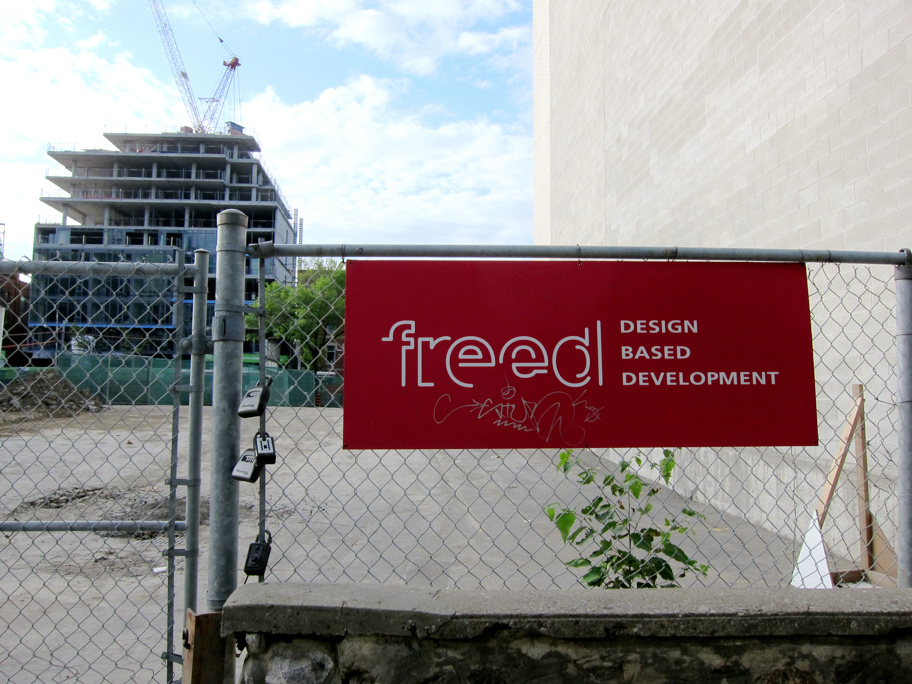 |
| Sign of the times... note the other Freed project also going up in the background |
Freed's projects in the King West area include:
- Fashion House
- Six50 King West
- Thompson Residences
- Seventy5 Portland
- 66 Portland
- 500 Wellington West
- 550 Wellington West
- 20 Stewart
- Thompson Hotel
- 455 Adelaide
The forthcoming addition to this list, of course, is the project at the Oasis site at Front and Bathurst, in partnership with Minto Group.
 |
| Freed's Kingdom: A crude map showing Freed's King West projects in red. (Proposed development with Minto in green) |
We might have denied to ourselves that it was ever going to happen -- but a sober examination of the transition and evolution of urban city neighbourhoods from industrial to mixed uses, suggests that the demolition of the Rock Oasis climbing gym was practically unavoidable.
 |
| The glass corridor of Stewart St. |
Condos and gentrification mean goodbye Rock Oasis
Thousands of people now live in condos built by Freed and other developers in the King West neighbourhood. Thousands more work, shop and dine every day and night in the area's businesses and restaurants.
Stand in the middle of Victoria Memorial Park, and take a look in each direction. The 200 year-old cemetery is surrounded -- by new buildings. What you see is a stark reflection of how development has invigorated the area in the last decade.
 |
| Is this consistent with the industrial heritage of the area? Just asking. |
Millions of dollars of investment flooded the district in recent years. This had inevitable consequences.
With every crisp new development in the King West area, the land values of the remaining 'undeveloped' sites rocketed upwards. The corresponding tax assessments made it virtually impossible, financially, for the prior building owners at 27 Bathurst to continue to maintain the site in its present form. They could no longer rent the space at a rate which made any commercial sense.
"Speculation is driving land values up. With that property taxes driven by the same market values are inflating. Heritage buildings are seeing tax bills in some cases jump from $8m to $23m in a single year. With locked in leases property owners are selling to avoid bankruptcy. New owners buy knowing they will have to demolish and redevelop just to pay the taxes.
Developers are demanding more height and density to cover costs; they find it cheaper to demolish heritage buildings than creatively re-use them."
- Adam Vaughan, Ward 20 Councillor, responding to Steve Ladurantaye's March 2011
Globe and Mail profile of Peter Freed.
This is a trend which can be expected to continue -- it has become cheaper to demolish a heritage structure and sell off the land for development, than to convert it or continue to lease it in an attempt at preservation.
It's hard to argue that this isn't a positive development overall, if not in specific. Freed is no villain in this drama. He is a visionary. The King West area has visibly improved over the last fifteen years, into a destination location where people want to live and shop. The city's experimental policy regime has paid handsome dividends -- both in terms of taxation revenues, and general livability. Investments in infrastructure and development continue to revitalise the neighbourhood.
It's just sad that Oasis has to go.
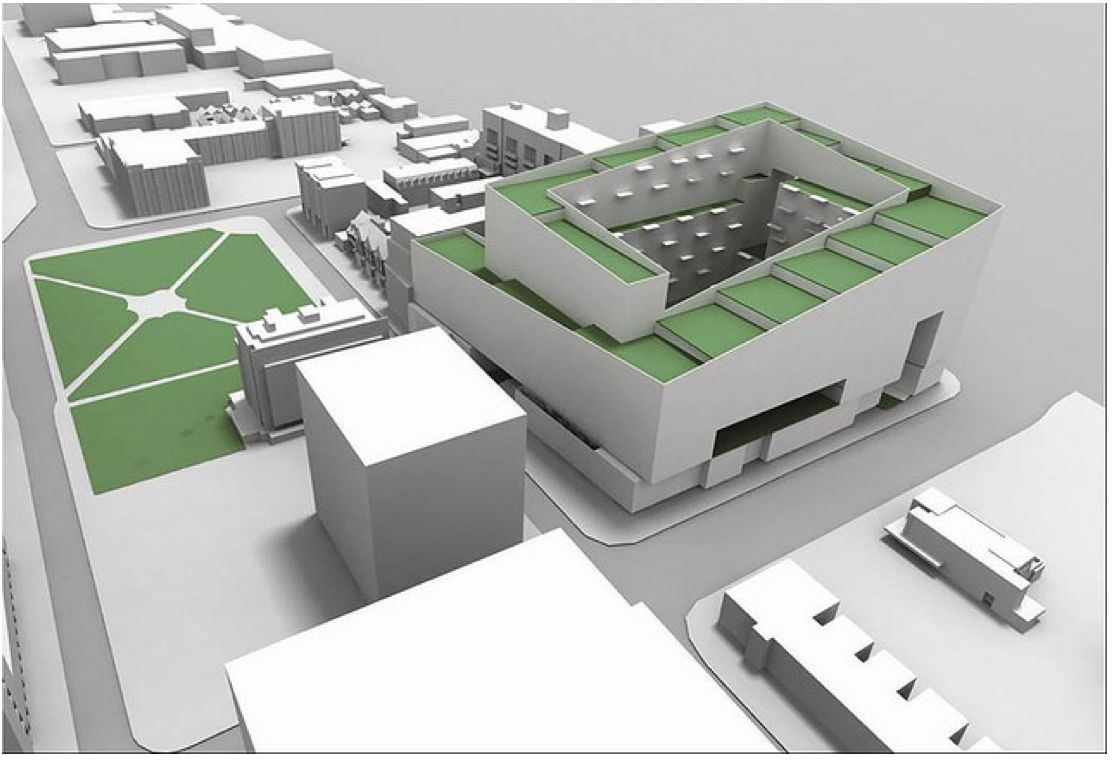 |
| An early rendering of the proposed development. Ummm.... (Please note: this is NOT representative of the current plans, which I have not seen) |
The site of Rock Oasis was purchased for a reported $42 million in the summer of 2010. Freed Developments, in alliance with Minto Group, has floated plans for its largest project yet, with a proposed 970 units in a 900,000 square foot complex designed by Rudy Wallman (yes, the project architect at 20 Niagara!). The design includes a park set within four towers, above a retail podium, ranging in height from 4 to 22 stories, and a private courtyard. A Whole Foods grocery store is rumoured to be taking on the ground level frontage on Bathurst.
The Doty Engine Works building is correspondingly slated to be demolished in the summer of 2011, to make way for the sales office for the new development, which itself will be completed around 2015.
This was something that, deep inside, we always knew was going to happen. We just never believed it would come this soon.
Failure to Conserve our Industrial Heritage
 Toronto is a city that has oft struggled with preserving its heritage structures. This development fits the trend.
Toronto is a city that has oft struggled with preserving its heritage structures. This development fits the trend.I suppose I still feel bitter with respect to the demolition. I know we eventually have to recognize that it happened, and learn to deal with it.
Indeed, when I've just written an extended exposition of the many changes that Front and Bathurst has seen since incorporation of Toronto, it would be strange for me to argue that things must stay the same, preserved forever in amber. When the Rescue Inn was torn down after forty years of service, were there legions of misty-eyed former patron soldiers who lamented its final demise in the name of ‘progress’?
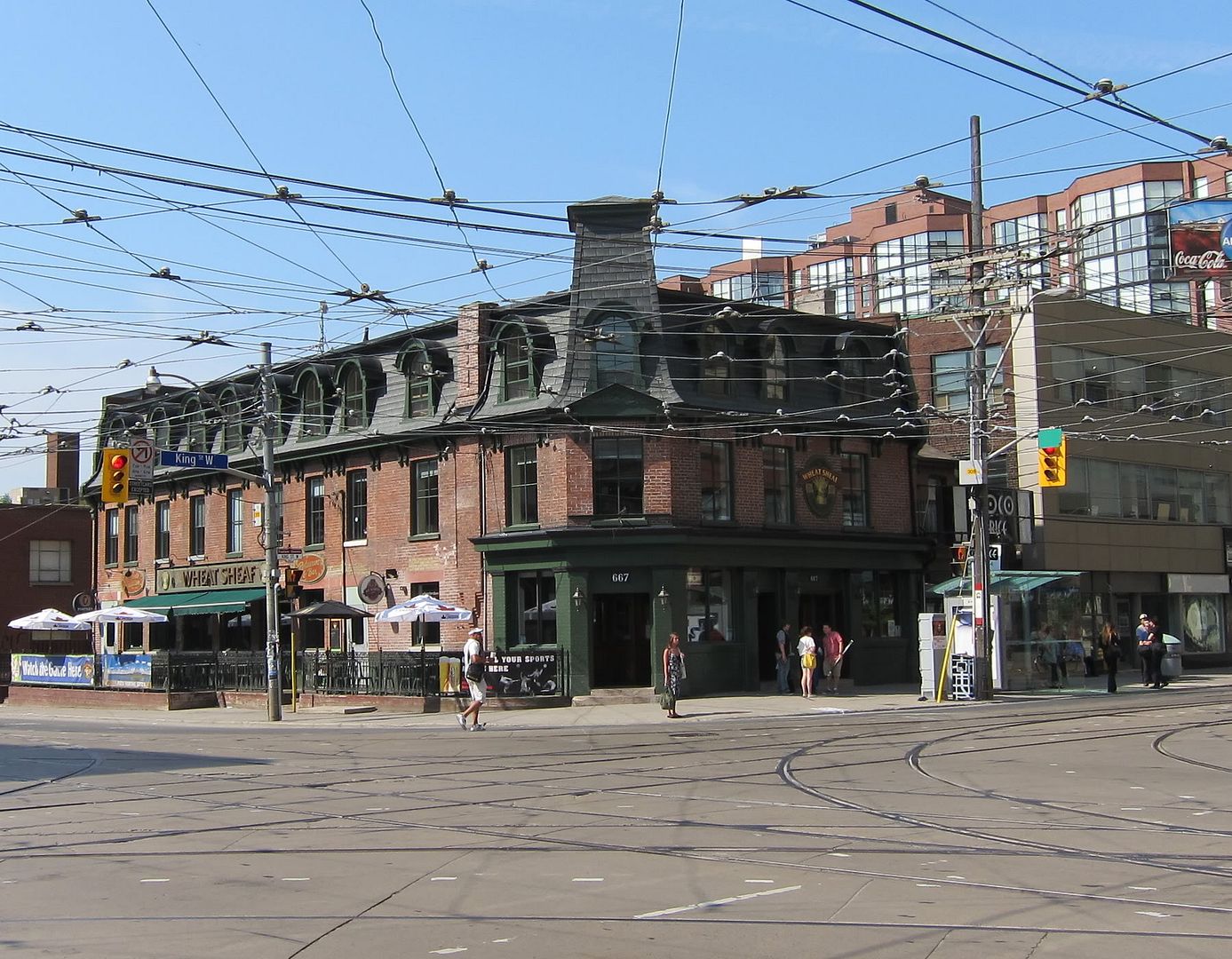 |
| Even the Wheat Sheaf has been spruced up to look pretty good these days |
This time Drake, it's not all your fault
|
Yet two of of the key goals identified in the King Spadina Secondary Plan policy were:
"to ensure that new development is of a scale and form that complements the historic building stock and structure of the public realm"and
"to retain, conserve, rehabilitate, re-use, and restore heritage buildings."
We've failed at the latter.
How tremendously disappointing, that the Oasis building couldn't be saved as a heritage structure. The Doty Engine Works, and the site it sits on, are an important touchstone to Toronto's industrial history, both in terms of architecture and past usage. Its latest incarnation as a climbing gym was a superb example of how a legacy structure can be imaginatively put to productive use.
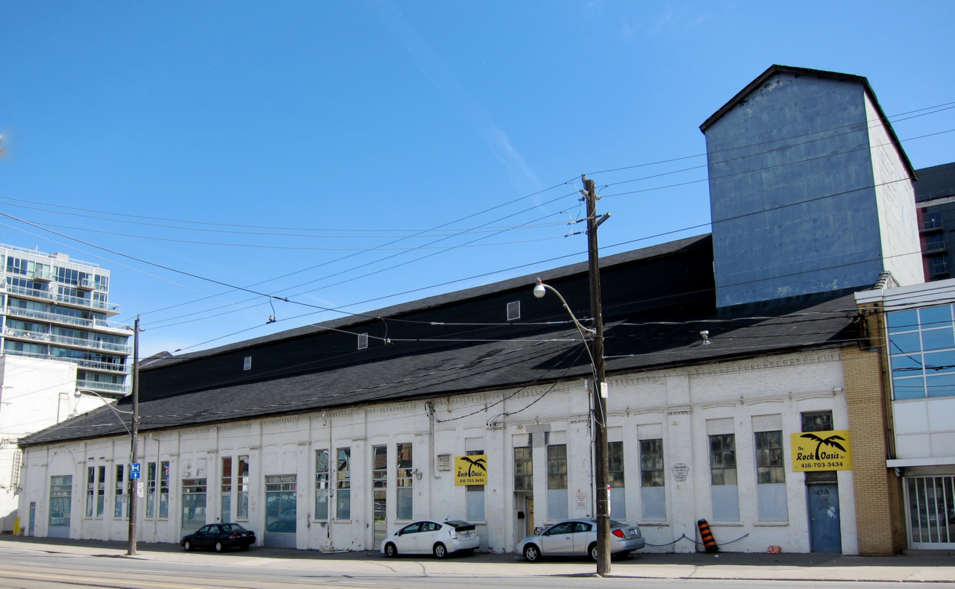 |
| Goodbye old shack. It's time to rest your weary bones. Thank you for the joy you gave us! |
Like the proverbial frog in a pot of gradually heated water, we failed to realize that the development temperature was heating up to the boiling point, even when the signs were clearly all around us.
Shouldn't we have recognized the trend, and done something about it? If we had worked to place the building on a heritage list years ago, would things have turned out differently? The day Crangle's was sold, I wrote an e-mail to two of my climbing friends asking, 'Do you ever wonder if one day we'll wake up, come to the gym and it'll be gone?'
That day has sadly come.
Our identity is formed from an accumulation of experiences, and a collective understanding of that which has come before. When we allow structures like the Doty Engine Works to be demolished, we risk losing that tangible -- but ever so tenuous -- connection with our past.
When we deliberately choose to erase the lingering artifacts of times gone by, we lose something of ourselves.
Read the next section:
You're reading: Farewell to Rock Oasis, the secret history of my home climbing gym.
Table of Contents
Like, Share, or Comment on this post!



